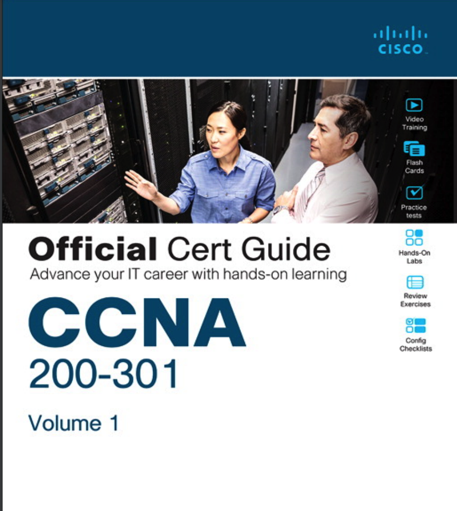Exclusive Courses | Cisco CCNA Simplified - Full Book
[Scrolling PDF] Cisco CCNA Simplified - Full Book
- Experienced instructors with industry expertise
- Access to official guides and materials
- Covers all exam topics thoroughly
- Flexible study at your own pace
- Support for exam service
- Anytime access to study resources
What you'll learn
Training Course Outline
Cisco CCNA Simplified - Full Book [Scrolling PDF]
Training Options
Self Paced Learning
- Lifelong access to high-quality content
- Curated by industry experts
- Customized learning progress
- 24/7 learner assistance and support
- Follow the latest technology trends
Exam Dump
- 100% Real Exam Practice Tests
- 100% Verified Exam Questions & Answers
- 100% Guarantee Passing Rate
- Average 7 Days to Practice & Pass
Description
The CCNA is an entry-level networking certification that can prepare you for networking roles in IT like network specialist, network administrator, and network engineer. 0:00:46 - Introduction to the 6th Edition PART 1: NETWORK FUNDAMENTALS 0:09:34 - Chapter 1: Network Fundamentals 0:22:39 - Chapter 2: Ethernet Concepts and Cabling 0:28:48 - Chapter 3: Router Architecture 0:32:02 - Chapter 4: Network Interfaces ... PART 7: NETWORK TROUBLESHOOTING 3:04:31 - Chapter 28: Network Troubleshooting 3:0
Pre-requisites
This course is designed for anyone seeking CCNA certification. The job roles best suited to the material in this course are: Entry-level network engineer Network administrator Network support technician Help desk technician

CCNA 200-301 Official Cert Guide Library
CCNA 200-301 Official Cert Guide Library is a comprehensive review and practice package for the latest CCNA exam and is the only self-study resource approved by Cisco.

2024 Updated Demo - SPOTO CCNA 200-201 V1.1 Demo
The Latest Demo for Cisco CCNA 200-201 CBROPS exam v1.1, the latest demo to help you prepare and pass the lab exam.

2024 Updated Demo - SPOTO CCNA 200-901 V1.1 Demo
The Latest Demo for Cisco CCNA 200-901 DEVASC v1.1 exam, the latest Demo to help you prepare and pass the lab exam.
CCNA Exam & Certification
Network Fundamentals in CCNA
The network fundamentals in CCNA cover essential concepts like the OSI and TCP/IP models, IP addressing (IPv4 and IPv6), subnetting, Ethernet standards, and network topologies. It includes understanding protocols such as TCP, UDP, and ICMP, as well as basic infrastructure components like routers, switches, and cabling. These fundamentals emphasize how data is transmitted across networks, including error checking, flow control, and the role of MAC addresses in local communication. Practical skills include configuring devices using CLI and tools like Packet Tracer to simulate network setups.
LAN Switching in CCNA
LAN switching focuses on how switches operate at Layer 2 (Data Link Layer) to forward frames based on MAC addresses. Key topics include VLANs (Virtual Local Area Networks) for segmenting broadcast domains, trunking protocols like 802.1Q, and Spanning Tree Protocol (STP) to prevent loops. Switching methods such as cut-through, fragment-free, and store-and-forward are explored to optimize performance and reliability. Configuration tasks involve setting up port security, managing MAC address tables, and implementing EtherChannel for load balancing.
Routing in CCNA
Routing in CCNA revolves around Layer 3 (Network Layer) protocols and how routers determine optimal paths using routing tables. Key protocols include RIP, OSPF, and EIGRP for dynamic routing, along with static routing. Concepts like administrative distance, route summarization, and inter-VLAN routing are critical. Troubleshooting routing issues, such as misconfigured routes or protocol mismatches, is emphasized. Practical labs often involve configuring default gateways, verifying routes with commands like show IP route, and simulating multi-router topologies.
Network Security in CCNA
Network security topics include securing devices with passwords, SSH, and role-based access control (RBAC). Access Control Lists (ACLs) are used to filter traffic, while features like port security and DHCP snooping mitigate Layer 2 attacks. The curriculum also covers firewall basics, VPNs (e.g., IPsec), and threat detection using Cisco IOS IPS. Security principles align with the CIA triad (Confidentiality, Integrity, Availability), addressing threats like DDoS, phishing, and unauthorized access. Hands-on labs focus on configuring AAA (Authentication, Authorization, Accounting) and securing network services.
WAN Technologies in CCNA
WAN technologies explore connections beyond local networks, including leased lines, MPLS, and VPNs. Protocols like PPP (Point-to-Point Protocol) and HDLC are used for serial links, while Frame Relay and DMVPN (Dynamic Multipoint VPN) enable scalable remote access. Concepts such as QoS (Quality of Service) and broadband technologies (e.g., DSL, cable) are introduced. Configuration tasks involve setting up site-to-site VPNs, troubleshooting WAN interfaces, and understanding cloud integration. These technologies ensure reliable, secure communication across geographically dispersed networks.
The significance of CCNA
The CCNA certification provides a comprehensive foundation in networking, starting with core concepts like the OSI model and IP addressing. It delves into LAN switching for efficient local data forwarding and routing protocols for inter-network communication. Security modules teach threat mitigation and device hardening, while WAN technologies extend connectivity to global scales. Together, these components prepare professionals to design, implement, and troubleshoot modern networks.